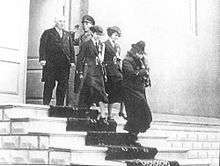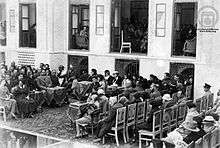Kashf-e hijab


Kashf-e hijab (Persian: کشف حجاب Unveiling) is an era in Iran's history. On 8 January 1936, pro-Western autocratic ruler Rezā Shāh issued a decree banning all veils (headscarf and chador) abruptly, swiftly and forcefully.[1][2][3][4][5] The government also banned many types of male traditional clothing, claiming that "Westerners now wouldn’t laugh at us".[6][7][8]
Impact
To enforce this decree, the police were ordered to physically remove the veil from any woman who wore it in public. Women were beaten, their headscarves and chadors torn off, and their homes forcibly searched.[1][2][3][6][7][8][9][10][11][12] Until Reza Shah's abdication in 1941, many women simply chose not leave their houses in order to avoid such embarrassing confrontations,[1][6][7][8][10] and a few even committed suicide.[6][7][8] A far larger escalation of violence occurred in the summer of 1935 when Reza Shah ordered all men to wear European-style bowler hats, which was Western par excellence. This provoked massive non-violent demonstrations in July in the city of Mashhad, which were brutally suppressed by the army, resulting in the deaths of an estimated 100 to 5,000 people (including women and children).[2][4][6][7][8][10][12]
Criticism
Western historians state that this would have been a progressive step if women had indeed chosen to do it themselves, but instead this ban humiliated and alienated many Iranian women,[3][9][10][13] since its effect was comparable to a hypothetical situation in which European women were suddenly ordered to go out topless into the street.[6][7][8][9] Historians often point that Reza Shah’s ban on veiling and his policies are unseen even in Atatürk's Turkey,[9][10] and some scholars state that it is very difficult to imagine that even Hitler's or Stalin's regime would do something similar.[6][7][8] The arbitrary decree by Reza Shah was criticized even by British consul in Tehran:[14]
Next to their daily bread, what affects the people most widely is what touches the code of social habit that, in Islam, is endorsed by religion. Among Muslims the Iranians are not a fanatical people. The unveiling of women inaugurated in the preceding year attacks the people’s social conservatism as much as their religious prejudice. Above all, like conscription, it symbolizes the steady penetration into their daily lives of an influence that brings with it more outside interference, more taxation. But one can easily exaggerate the popular effect of unveiling; it is a revolution for the well-to-do of the towns, but lower down the scale, where women perform outdoor manual labour, its effects both on habit and on the family budget diminish until among the tribal folk of all degrees they are comparatively slight. Hence resistance among the greater part of the people has been passive, and, where existing, has manifested itself in reluctance of the older generation to go abroad in the streets. It is one thing to forbid women to veil; it is another thing to make them mingle freely with men— [14]
Aftermath
Later, official measures relaxed slightly under next ruler Mohammad Reza Pahlavi and wearing of the headscarf or chador was no longer an offence, but for his regime it became a significant hindrance to climbing the social ladder as it was considered a badge of backwardness and an indicator of being a member of the lower class.[9] Discrimination against the women wearing the headscarf or chador was still widespread with public institutions actively discouraging their use, and some eating establishments refusing to admit women who wore them.[1][15] This period is characterized by the dichotomy between a small minority who considered wearing the headscarf as a sign of backwardness and the vast majority who considered it progressive.[2][3][5] Despite all legal pressures, obstacles and discriminations, the largest proportion of the Iranian women continued to wear headscarves or chadors, contrary to the widespread opposite claims.[1][6][7][8][10][14][15] Earlier in the mid-1930s, only four thousand out of 6.5 million Iranian women ventured into public places without veils, almost all in Tehran and consisting mainly of Western-educated daughters of the upper class, foreign wives of recent returnees from Europe, and middle-class women from the minorities.[14]
See also
References
- 1 2 3 4 5 Hoodfar, Homa (fall 1993). The Veil in Their Minds and On Our Heads: The Persistence of Colonial Images of Muslim Women, Resources for feminist research (RFR) / Documentation sur la recherche féministe (DRF), Vol. 22, n. 3/4, pp. 5–18, Toronto: Ontario Institute for Studies in Education of the University of Toronto (OISE), ISSN 0707-8412
- 1 2 3 4 Milani, Farzaneh (1992). Veils and Words: The Emerging Voices of Iranian Women Writers, Syracuse, New York: Syracuse University Press, pp. 19, 34–37, ISBN 9780815602668
- 1 2 3 4 Paidar, Parvin (1995): Women and the Political Process in Twentieth-Century Iran, Cambridge Middle East studies, Vol. 1, Cambridge, UK; New York: Cambridge University Press, pp. 106–107, 214–215, 218–220, ISBN 9780521473408
- 1 2 Majd, Mohammad Gholi (2001). Great Britain and Reza Shah: The Plunder of Iran, 1921–1941, Gainesville: University Press of Florida, pp. 209–213, 217–218, ISBN 9780813021119
- 1 2 Curtis, Glenn E.; Hooglund, Eric (2008). Iran: A Country Study, 5th ed, Area handbook series, Washington, DC: Federal Research Division, Library of Congress, pp. 28, 116–117, ISBN 9780844411873
- 1 2 3 4 5 6 7 8 Katouzian, Homa (2003). "2. Riza Shah's Political Legitimacy and Social Base, 1921–1941" in Cronin, Stephanie: The Making of Modern Iran: State and Society under Riza Shah, 1921–1941, pp. 15–37, London; New York: Routledge; Taylor & Francis, ISBN 9780415302845
- 1 2 3 4 5 6 7 8 Katouzian, Homa (2004). "1. State and Society under Reza Shah" in Atabaki, Touraj; Zürcher, Erik-Jan: Men of Order: Authoritarian Modernisation in Turkey and Iran, 1918–1942, pp. 13–43, London; New York: I.B. Tauris, ISBN 9781860644269
- 1 2 3 4 5 6 7 8 Katouzian, Homa (2006). State and Society in Iran: The Eclipse of the Qajars and the Emergence of the Pahlavis, 2nd ed, Library of modern Middle East studies, Vol. 28, London; New York: I.B. Tauris, pp. 33–34, 335–336, ISBN 9781845112721
- 1 2 3 4 5 El Guindi, Fadwa (1999). Veil: Modesty, Privacy and Resistance, Oxford; New York: Berg Publishers; Bloomsbury Academic, pp. 3, 13–16, 130, 174–176, ISBN 9781859739242
- 1 2 3 4 5 6 Chehabi, Houchang Esfandiar (2003): "11. The Banning of the Veil and Its Consequences" in Cronin, Stephanie: The Making of Modern Iran: State and Society under Riza Shah, 1921–1941, pp. 203–221, London; New York: Routledge; Taylor & Francis, ISBN 9780415302845
- ↑ Fatemi, Nasrallah Saifpour (1989). Reza Shah wa koudeta-ye 1299 (Persian), Rahavard – A Persian Journal of Iranian Studies, Vol. 7, n. 23, pp. 160–180, Los Angeles: Society of the Friends of the Persian Culture, ISSN 0742-8014
- 1 2 Beeman, William Orman (2008). The Great Satan vs. the Mad Mullahs: How the United States and Iran Demonize Each Other, 2nd ed, Chicago: University of Chicago Press, pp. 108, 152, ISBN 9780226041476
- ↑ Heath, Jennifer (2008). The Veil: Women Writers on Its History, Lore, and Politics, Berkeley; Los Angeles: University of California Press, pp. 66, 252–253, 256, 260, ISBN 9780520255180
- 1 2 3 4 Abrahamian, Ervand (2008). A History of Modern Iran, Cambridge, UK; New York: Cambridge University Press, pp. 84, 94–95, ISBN 9780521528917
- 1 2 Ramezani, Reza (2008). Hijab dar Iran, dar doure-ye Pahlavi-ye dovvom [Hijab in Iran, the second Pahlavi era] (Persian), Faslnamah-e Takhassusi-ye Banuvan-e Shi’ah [Quarterly Journal of Shiite Women], Qom: Muassasah-e Shi’ah Shinasi, ISSN 1735-4730